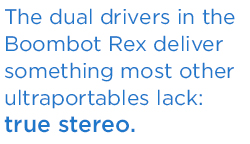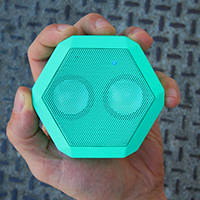Tom's Guide Verdict
With plenty of features, the rugged Boombot Rex is a good ultraportable Bluetooth speaker for on-the-go music lovers.
Pros
- +
Rugged build, waterproof
- +
Speakerphone with Siri integration
- +
Can daisy chain with other speakers for more fidelity
Cons
- -
Expensive for ultraportable Bluetooth speaker
- -
Weak treble and bass tones
Why you can trust Tom's Guide
You want an ultraportable Bluetooth speaker that can handle the abuse you'll dish out — whether that's hanging with friends around the pool or around the fire at a campsite. Boombotix's $100 Boombot Rex welcomes the bumps and splashes that inevitably happen when you take music out into the wild. Beyond its rugged build, the speaker also packs in features like a speakerphone and Siri integration. But is it worth the premium over other inexpensive speakers such as the $50 JBL Clip?
Design

At 3.3 x 3.1 x 1.8 inches and 8 ounces, the Boombot Rex isn't much bigger than the 4.2 x 3.5 x 1.7-inch, 5.3-ounce JBL Clip, but it's built of sturdier stuff. Encased in hard ABS plastic, the Boombot Rex feels like it can take a licking, and its IP53 rating backs that up. The device can withstand dust or a spray of water, but don't submerge it in liquid. In comparison, the JBL Clip doesn't offer any weather protection, while the Boom Swimmer can be submerged in 3 feet of water for 30 minutes.
Aesthetically, the Boombot Rex aims to stand out from the crowd. Not only does it have a hexagonal shape, but it's available in one of eight patterns, including basic black or white, bright orange and "mudrunner," a brown that has tire treads imprinted on it. (The mudrunner style costs an extra $20.)
The power, volume and play buttons are on the top of the Rex. Hold down the play button if you're using an iOS device to activate Siri, place calls or pick a song to play from your Music app. On another side of the speaker, there's a micro USB port to charge the device. Opposite the micro USB port, you'll find a 3.5mm auxiliary input for wired connections, as well as an output jack — a nice extra that lets you string together multiple speakers to create a wider sound.
MORE: Best Bluetooth Speaker
The only visual cue the Boombot Rex includes is a single LED under the grille. It shines blue when it's connected to a device, blinks when it's in Bluetooth discovery mode and blinks red when the battery dips below 10 percent. The speaker also uses a very loud sound to indicate that you've turned it on and chirps loudly when it connects to a device. In shared environments, these audio prompts will annoy people around you.
To make the Boombot Rex easy to tote, the company added a belt clip to the back. Though it does the job, it is extremely stiff and can be difficult to open. JBL's Clip includes a carabiner, which I found to be a better solution.
Get instant access to breaking news, the hottest reviews, great deals and helpful tips.
Setup and Use

I connected the Boombot Rex easily with iOS and Android devices via Bluetooth. The speaker goes into pairing mode when you turn it on; you don't need to push any buttons.
On an Android device, go to Settings and look for the speaker listed in Available Devices. (You may need to touch Search for Devices.) In iOS, go to Settings > Bluetooth, where the Boombot Rex should appear under Devices.
Boombotix doesn't state the range for the Bluetooth connection, but I found that the signal started to break up about 20 feet from the speaker — not very impressive compared with most ultraportable speakers, including the Boom Swimmer, which maintained a strong signal at 30 feet.
Audio Performance

The dual drivers in the Boombot Rex deliver something most other ultraportables lack: true stereo. Though they are small, the drivers help to create a wider sound field than what you'll find on the Boom Swimmer.
Overall, the Boombot Rex delivered good, but not great, audio quality. On pop songs such as Lorde's "Team," vocals sounded full. But the speaker didn't deliver much punch in the bass or treble tones. Spoon's "Outlier," which features driving drums and bass, lacked depth. On Charles Mingus' jazz classic "Goodbye Pork Pie Hat," the saxophones sounded rich, but the piano and bass in the background were thinner than on JBL's Clip.
The Boombot Rex gets loud without distorting sound, and delivered a better audio experience in that area than the Clip or Swimmer. I started to hear some distortion from the Rex above 85 dB at 3 feet, which is the top safe volume for listening.
MORE: Our Favorite Headphones Available Now
If you have more than one Boombot Rex, or any powered speaker that has an auxiliary input, you can daisy chain the speakers together through the Boombot Rex's 3.5mm output. Adding more speakers helps create an even wider field of sound, producing an encompassing effect.
Speakerphone
The Boombot Rex's speakerphone worked well, and both ends of the line sounded clear. People on the other end of my calls said I sounded louder when I was using the Boombot Rex than when I was using the iPhone's built-in speakerphone.
You can answer calls by pushing the play button on the top of the speaker. If you hold down the play button for a few seconds and you're connected to an iPhone with Siri, you can engage the virtual personal assistant to make calls.
Battery Life
Boombotix says the Boombot Rex can play for 8 hours on a full charge, and I found that to be accurate. That's much better than JBL's Clip, which gets only 5 hours at best, but not as impressive as the Boom Swimmer, which is capable of 16 hours of playback at half volume.

Bottom Line
The Boombot Rex is packed with features, and you pay a premium for those compared to other ultraportables, like JBL's $50 Clip and Boom's $60 Swimmer. Though the Rex produces good overall sound, it can't compete with the Clip in audio quality. But if you plan to play rough with your Bluetooth speaker and want something to stand up to the elements, the Boombot Rex is a sound choice.
Specs:
2 x 1.4-inch drivers plus woofer
Size: 3.3 x 3.1 x 1.8 inches
Weight: 8 ounces
Inputs: Bluetooth, 3.5mm auxiliary input
- Guide to Gaming: What Are Steam Machines?
- Mobile Security Guide: Everything You Need to Know
- The Hottest TVs of the Year
Follow Michael Gowan @zebgowan and on Google+. Follow us @tomsguide, on Facebook and on Google+.

Michael Gowan is a freelance technology journalist covering soundbars, TVs, and wireless speakers of all kinds of shapes and sizes for Tom’s Guide. He has written hundreds of product reviews, focusing on sound quality and value to help shoppers make informed buying decisions. Micheal has written about music and consumer technology for more than 25 years. His work has appeared in publications including CNN, Wired, Men’s Journal, PC World and Macworld. When Michael’s not reviewing speakers, he’s probably listening to one anyway.

